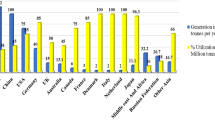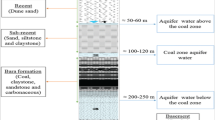Abstract
In South Korea, nine million tons of fly ash (FA) are annually produced and approximately 70 % is reutilized for industrial demand. For the prompt reuse and insufficient reclamation site, quality control of FA which is main productive construction material from coal ash is very important. Assessed Pozzolanic-activity Index (API) test which needs only 2 days for evaluation of pozzolanic reaction is currently considered as an alternative of activity index measurement. This paper aims for an applicability of API test for prompt quality control and investigation of domestic FA properties. For the work, FAs from two different power plant types are prepared, and quality tests are carried out based on Korean Standards (KS) methods and API method. Lots of test results are compared with those from API and K-value test for FA with age of 7 days–1 year. From the test results for FA aged 1 year, API results are evaluated to be closely related with those from activity index and K-value, and the correlations are improved with increasing ages regardless of plant types. The applicability of API test is verified and the reduced period of FA quality evaluation can accelerate prompt use and the related process of FA.











Similar content being viewed by others
References
Lee HK, Kim HK, Hwang EA (2010) Utilization of power plant bottom ash as aggregates in fiber reinforced cellular concrete. Waste Manage 30:274–284. doi:10.1016/j.wasman.2009.09.043
Jung SH, Kwon S-J (2013) Engineering properties of cement mortar with pond ash in south Korea as construction materials: from waste to concrete. Centr Eur J Eng 3:522–533. doi:10.2478/s13531-012-0068-3
Peng Y, Zhang J, Liu J, Wang F (2015) Properties and microstructure of reactive powder concrete having a high content of phosphorous slag powder and silica fume. Const Build Mater 101:482–487. doi:10.1016/j.conbuildmat.2015.10.046
Kandasamy S, Shehata MH (2014) Durability of ternary blends containing high calcium fly ash and slag against sodium sulphate attack. Const Build Mater 53:267–272. doi:10.1016/j.conbuildmat.2013.11.080
Hossain MM, Karim MR, Hossain MK, Islam MN, Zain MFM (2015) Durability of mortar and concrete containing alkali-activated binder with pozzolans: a review. Const Build Mater 93:95–109. doi:10.1016/j.conbuildmat.2015.05.094
Yoo SW, Jung SH, Kwon S-J (2014) Evaluation of compressive strength and shear strength characteristics in high volume fly ash concrete. App Mech Mater 2014:1282–1288. doi:10.4028/www.scientific.net/AMM.584-586.1282
Song H-W, Kwon S-J (2009) Evaluation of chloride penetration in high performance concrete using neural network algorithm and micro pore modeling. Cem Concr Res 39:814–824. doi:10.1016/j.cemconres.2009.05.013
Tang L (1996) Electrically accelerated methods for determining chloride diffusivity in concrete-current development. Mag Concr Res 23:347-353. OI: 10.1680/macr.1996.48.176.173
Ishida T, Maekawa K (2003) Modeling of durability performance of cementitious materials and structures based on thermo-hygro physics, RILEM Proceedings PRO 29: Life Prediction and Aging Management of Concrete Structures, 39–49. doi:10.1617/2912143780.005
Saraswathy V, Song H-W (2007) Improving the durability of concrete by using inhibitors. Build Envir 42:464–472. doi:10.1016/j.buildenv.2005.08.003
Maekawa K, Ishida T, Kishi T (2003) Multi-scale modeling of concrete performance. J Adv Conc Tech 1:91-126. http://concrete.t.u-okyo.ac.jp/en/demos/ducom/brieftheory/91-126.pdf
Neville AM (1999) Properties of Concrete, Longman, 4th edn, 269–311
Korea Concrete Institute (2011), Concrete and Environment, Kimondang press, 28–36 (in Korean)
Lee J-M, Kim D-W, Kim J-S (2010) Characteristics of co-combustion of anthracite with bituminous coal in a 200-MWe circulating fluidized bed boiler. Energy 36:5703–5709. doi:10.1016/j.energy.2011.06.051
Yamamoto T, Kanazu K (1999), Accelerated chemical assessing method for pozzolanic activity of fly ash. CRIEPI Abiko Research Laboratory Rep. No. U98047, Technical Report (in Japanese)
Korean Standard Association (2009), Korean Standard- L 5405, Fly Ash, pp 1–12
ASTM (2012) ASTM C618-12a, Standard Specification for Coal Fly Ash and Raw or Calcined Natural Pozzolan for use in Concrete
British Standard (2012) BS EN 450-1, Fly Ash for Concrete, Part 1, BSI Standards Publication
Chinese National Standards (2005) GlGB/T 1596, Fly ash used for cement and concrete
Japan Industrial Standards (2015) JIS A 6201, Fly ash for concrete
Choi Y-W, Park M-S, Choi B-K, Oh S-R (2014) The properties of strength development of high volume fly ash concrete with reduction of unit water content, J Rec Const Resources 2:46–51. http://dx.doi.org/10.14190/JRCR.2014.2.1.046
Yamamoto T, Kanazu T, Nambu M, Tamosaki T (2006) Pozzolanic reactivity of fly ash—API method and K-value. Fuel 85:2345–2351. doi:10.1016/j.fuel.2006.01.03
Ahn YJ, Moon KJ, Yoon SJ, Lee MH, Kim YR (2013) Physical properties of finishing mortar in Ondol floor using high-calcium fly ash. J Korea Society waste manage 30:660–669 [in Korean]
Sasaki H, Shintani N, Kita T, Fukudome K (1997) Studies on the effective utilization of coal ash generated from pressurized fluidized-bed combustion power plant. J Japan Concr Inst 19:229–234
Sim JS, Lee KG, Kim YT, Kang SK (2012) Hydration characteristics of coal-fly ash containing high CaO compound. J Korean Cera Soc 49:185–190 [in Korean]
Itaru H, Makoto I, Tanaka M, Hukumoto D (2008) Compressive strength of PFBC coal ash composite with resistance to sulfuric acid solution. Proc Japan Concr Inst 30:529–534
Moon KJ, Park WC, Sho SY, Kwon WT (2007), PFBC coal ash composite with resistance to sulfuric acid solution,, J Korean Cera So
Mehta PK (1985) Influence of fly ash characteristics on the strength of Portland-fly ashmixtures. Cem Concr Res 15:669–674. doi:10.1016/0008-8846(85)90067-5
Yamamoto T, Kanazu T (2000) Chemical assessment method for the preventive effect of fly ash on alkali–silica reaction, Proc 11th Inter Conf AAR 801–810
Feng X, Clark B (2011), Evaluation of the physical and chemical properties of fly ash products for use in portland cement concrete, 2011 World of Coal Ash(WOCA) Conf. 1:1–12
Song H-W, Kwon S-J, Lee SW, Byun KJ (2003) A study on resistance of chloride ion penetration in ground granulated blast-furnace slag concrete, J Korea Conc Inst 15: 400–408 (in Korean)
Maekawa K, Ishida T (2002) Modeling of structural performances under coupled environmental and weather actions. Mater Struct 35:591–602. doi:10.1007/BF02480352
Acknowledgments
This work was supported by the Nuclear Research and Development of the Korea Institute of Energy Technology Evaluation and Planning (KETEP) grant funded by the Korea government Ministry of Knowledge Economy. (No. 20111010100030). The authors also appreciate for the support by Basic Science Research Program through the National Research Foundation of Korea (NRF) funded by the Ministry of Science, ICT & Future Planning (No.2015R1A5A1037548).
Author information
Authors and Affiliations
Corresponding author
Rights and permissions
About this article
Cite this article
Yoo, SW., Cho, Y.K., Jung, SH. et al. Quality control for coal combustion products in South Korea through assessed pozzolanic-activity index with long-term property tests. J Mater Cycles Waste Manag 19, 694–711 (2017). https://doi.org/10.1007/s10163-016-0465-4
Received:
Accepted:
Published:
Issue Date:
DOI: https://doi.org/10.1007/s10163-016-0465-4




